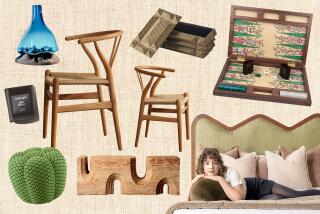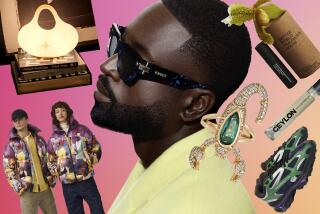The Color of Money
- Share via
It’s been a suspenseful wait. The latest interior design fad--designer wall paint--appeared waylaid as Martha Stewart’s oil-based home paint was banned in the basin by the South Coast Air Quality Management District for emitting too many VOCs (volatile organic compounds). But, not to fear, a water-based latex from Stewart should be arriving about Labor Day.
Officials figure that 60 tons of these paint-generated VOCs are released into the region’s air, more pollution than from all oil refiners and gas stations. Southern California has some of the strictest paint guidelines in the nation, and further tightening is expected this fall.
Stewart and Ralph Lauren--the first two big-name “lifestyle” designers to enter the uncharted designer wall paint arena--are trying to crack the long thrifty-conscious retail paint market. But first, the designers must convince consumers, interior designers and contract painters that the way they have been taught since the 1950s to purchase paint is outmoded. No longer roller-brush, do-it-yourself, their key words are “quality,” “durability,” “august color” and “craft.”
Although most in-the-know painters were set to pooh-pooh the designer brands, the products have generally received high marks. Still, many in the field believe the designers have an uphill battle.
“Paint is not the high-end product in the U.S. as it is in Europe,” explains Donald Kaufman, an artist turned color consultant. “Here people have been taught that paint is a catalog item: Why buy a gallon of paint for $30 if you can buy the same paint for $15?” Kaufman, based in New York, has a retail line of 30 colors and guesstimates he’s mixed nearly 50,000 colors. “It’s a common assumption that paint can be matched easily by anyone, and that paint is all the same. It’s not true. Paint is subtle and complex, as complex as you want to make it.”
“It’s the difference between cashmere and polyester,” says John Lehy, president of Fine Paints in Europe, the Vermont company with whom Stewart collaborates. “[In Europe,] paint is not a low-end product, nor a low-end craft. I think this is where Martha’s attention is headed.” Lehy says their first collaboration, the 1992 Colors of the Garden (whose colors Stewart found in a 1901 antique garden book) had lovers luck: They premiered with the sold-out premiere issue of Martha Stewart Living (the magazine). Voila, American designer paint was born.
Both designers have hooked up with top paint companies: Sherwin-Williams has licensed Lauren, and Stewart’s newest paint collection, Araucana, is made by the Dutch company Schreuder. It was inspired by the unorthodox pigments and hues of the eggs laid by the Araucana and Ameraucana chickens Stewart raises. From Ameraucana Buff to Partridge Rock Brown to Salmon Faverolle, in the world of Martha Stewart, there is no mere beige or brown.
For interior designers, this hardly rocks their world. “Interior designers have always been able to mix paints, so designer paint is nothing new,” says Jason Titus of Irvine. He does concede that people ingest what designers think in terms of design and believes that it’s here that Lauren, Stewart and others will leave their mark.
“At first, I thought, big deal: There’s going to be paint with someone’s name on it so they can charge twice the price,” says Jeff Bugbee, a San Diego paint consultant. Now, he extols not only Lauren’s color but its texture. “These are new products, not just recycled goo.”
Introduced earlier this year and sold at selected Home Depot stores, Ralph Lauren Paints appears to be the front-runner in terms of innovation. There are 400 custom colors in four water-based sheens: matte, stain, semi-gloss and gloss. Most notable, however, are what Lauren terms three Unique Finishes. River Rock (24 colors) looks like “stream-washed, weathered rocks,” according to the designer, and Duchesse Satin (12 colors) captures the “elegance of a charmeuse evening gown.” The Suede Finish has 24 colors.
The company also presents new applications so walls can be transformed into Denim (16 colors), Chambray (16 colors), Antiqued Leather (16 colors) and a Historic Crackle. Don’t you love the names? Price per gallon: $20. By comparison, a typical brand runs about $15.
Stewart is countering Lauren’s move into mass products with her upscale choice of European paint. Martha’s paint will fetch between $75 and $110 per gallon. A higher number of imported pigments, less fillers and the brand name justify the price, Lehy says. In L.A. it will be available at Mann Brothers Paint Co. or through Liberon ([800] 245-5611).
Are the major paint companies shaking in their boots? Glidden-ICM and Benjamin Moore Paints declined to comment. But since designer paint is still a trial product, both designers are going slow. Lauren is releasing his paints to individual Home Depot stores to check consumer reaction. (“Positive,” says a representative of a San Diego outlet.) Martha sells well in the East and anticipates “a good response” here, Lehy says.
If it does fly, think of the possibilities--are you ready for Isaac Mizrahi Magenta?


